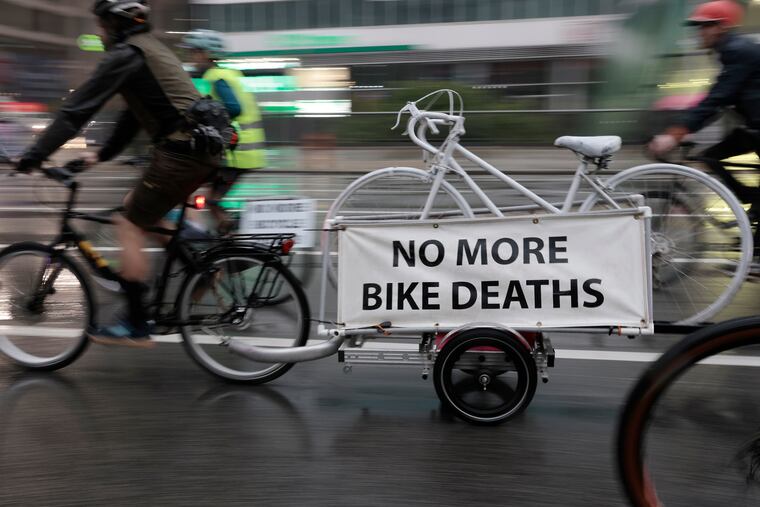Bike safety laws every Philadelphian should know: From your rights as a cyclist to dealing with angry drivers
No more “rolling stops,” leave the headphones at home, and remember that bikes can take the full lane.

Every week, five children in Philadelphia are hit by cars. More than 120 traffic deaths occur annually in the city, with the already high number of hit-and-runs increasing each year. These tragedies share a common factor: They are preventable.
That’s the crux of Philadelphia’s Vision Zero traffic safety plan, which aims to eliminate traffic deaths in the city within the next 25 years. Philly is among several dozen cities in the U.S. participating in this global movement, started in Sweden in the late ‘90s, to build road infrastructure and implement safety laws in car-centric urban areas.
Philadelphia is installing cameras on Roosevelt Boulevard to curb speeding, redesigning roads like Washington Avenue to reduce traffic, and receiving hundreds of millions in grants from federal, state, and local organizations for infrastructure projects such as the Chinatown Stitch.
“We have a goal of a network of connected and protected bike lanes,” said Nicole Brunet, policy director of the nonprofit Bicycle Coalition of Greater Philadelphia. “In order to do that, we need funding and we need to prioritize taking care of our streets and adding improvements.”
More than 100 people die in vehicular crashes every year in Philadelphia. Last year, 10 cyclists were killed, the highest number ever recorded in the city, according to the coalition. Since the COVID-19 pandemic, traffic deaths have surged and have not returned to pre-pandemic levels, with most crashes affecting lower-income communities of color, according to the city’s 2023 Vision Zero report.
Advocates now face additional challenges after Mayor Cherelle L. Parker announced cuts to Vision Zero by nearly half, over the next six years.
As the city’s cyclists await more improvements, The Inquirer spoke to local bike experts, Brunet and Caleb Holtmeyer of Philly Bike Action, for safety tips and guidance on biking in Philadelphia, covering cycling rights and dealing with aggressive drivers.
Bike safety laws every Philadelphian should know
Under the law, bicycles are considered the same as motor vehicles and must follow all of the same traffic laws. Keep this in mind when riding a bike or interacting with a cyclist on the road.
These safety rules and laws, curated by the Bicycle Coalition of Greater Philadelphia, will help ensure a safer time out on these Philly streets.
Stop at red lights and not in the crosswalk
All vehicles, including bikes and scooters, must stop at stop signs and red lights. Rolling stops create confusion and increase crash risks.
Stopping behind the crosswalk provides pedestrians a safer crossing.
Ride on the street, not on the sidewalk
Only cyclists 13 and younger can legally ride on the sidewalk. This rule keeps walkways clear for pedestrians and reduces confusion at crosswalks.
That being said, it can be dangerous at times to ride a bike on Philly streets. Some cyclists will occasionally ride on the sidewalk in busy intersections and roadways to avoid reckless drivers, but this should be done sparingly.
“Personally speaking as someone who rides their bike in the city, if I’m going through Grays Ferry Avenue and 34th Street, I’m going to get on the sidewalk because that intersection isn’t made for cyclists,” Brunet said.
In 2019, award-winning civic leader and cycling advocate Kyle Shenandoah — who brought job fairs to South Philadelphia, advocated for safer bike infrastructure, and organized campaigns to improve bus routes in his Grays Ferry neighborhood — was struck and killed by a driver at the Grays Ferry Avenue and 34th Street intersection.
A commemorative white “ghost bike” stands fastened to a pole at this intersection.
Take the lane
State law allows bicycles to take the full lane if there are no viable bike lanes. Cars should only pass cyclists if there is at least four feet of distance between them. On narrow one-way streets, cars should not attempt to pass cyclists.
“I can take up the whole lane if there’s not a bike lane and there isn’t enough space to allow for four feet of passing. I have a legal right to be there,” Brunet said.
But, any cyclist in Philadelphia will say that taking the full lane is a lot easier said than done.
“When I first moved to Philly, I had a lot of really poor experiences on the streets. I remember riding somewhere around Queen Village, a one-way street with cars parked on both sides,” Holtmeyer said. “I remember being harassed at least a few times riding in the area. I’m just riding my bike in the middle of the street and people will be very hostile, violent, and try to run me off the road.”
Use hand signals
Use hand signals to communicate with drivers and pedestrians when turning. This can limit the chances of confusion or a collision.
Even when using hand signals, stay vigilant. Drivers may often see the hand but not pay it any heed.
Ride with traffic, not against it
While it may feel safer to ride against traffic to see approaching cars, it’s technically not legal. Bikes, like cars, need to travel with the flow of traffic.
Mount bike lights, reflectors, and bells for visibility
Pennsylvania law requires bikes to have front and rear lights, a rear reflector, and a bell to make cyclists more visible and provide an extra means of communication.
Leave the headphones at home
It is illegal to wear headphones or earbuds in one or both ears while riding a bike in Pennsylvania (albeit rarely enforced). Being able to hear surrounding cars and activity is crucial for safety.
Despite the challenges, local organizations continue to push for safer biking conditions. Holtmeyer advises cyclists to channel their frustrations into advocacy by joining community organizations, contacting local council members, and engaging with cycling advocacy groups.